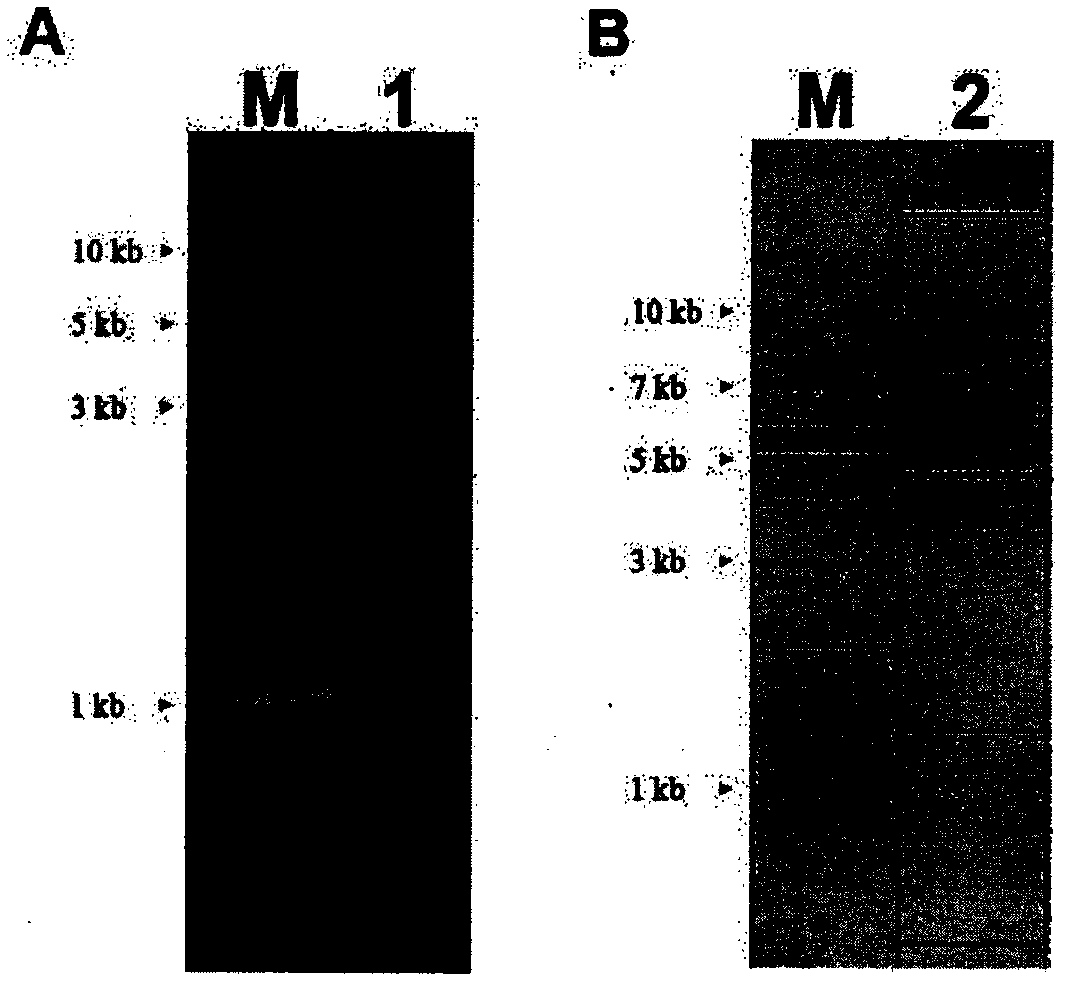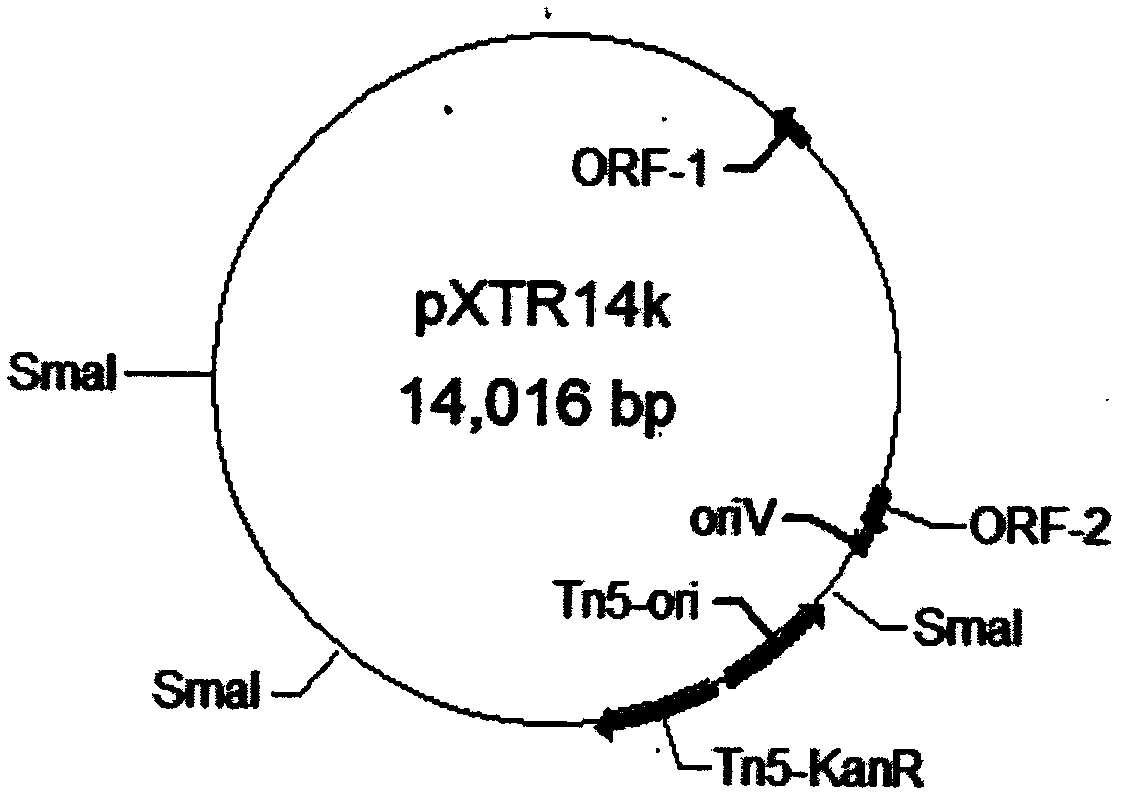Shuttle plasmid based on xanthomonas and application of shuttle plasmid
A technology of shuttle plasmids and Xanthomonas, which is applied in Xanthomonas-based shuttle plasmids and its application fields, can solve the problems that cannot meet the needs of the development of functional genomics of Xanthomonas, large plasmids, etc., and achieve stable replication Effects of loss, good affinity, and clear copy number
- Summary
- Abstract
- Description
- Claims
- Application Information
AI Technical Summary
Problems solved by technology
Method used
Image
Examples
Embodiment 1
[0042] Example 1 Extraction of Endogenous Plasmid pXOCgx01 from Rice Stripe Bacteria GX01 Strain
[0043] The endogenous plasmid pXOCgx01 was extracted from the rice leaf spot fungus GX01 strain by conventional plasmid extraction method. figure 1 , which coincided with electronic digestion, confirmed that the plasmid was the extracted endogenous plasmid pXOCgx01.
[0044] exist figure 1 middle:
[0045] A is the electropherogram of the extrachromosomal DNA directly extracted from Xoc GX01 after digestion, that is, lane 1;
[0046] B is the electronic restriction map of the sequencing splicing sequence simulated by Vector NTI software, that is, lane 2;
[0047] M refers to DNA marker (TianGen, 1 kb DNA Ladder).
[0048]The full length of the pXOCgx01 plasmid is 53,206bp. By comparing the coverage depth results of high-throughput sequencing, the normal copy number of the pXOCgx01 plasmid in the Xoc GX01 strain cells is 4. Experiments have proved that the pXOCgx01 plasmid ca...
Embodiment 2
[0049] Example 2 Insert pXOCgx01 plasmid in Escherichia coli and extract pXTR series plasmids
[0050] In order to construct the shuttle plasmid, the present invention uses EZ-Tn5 TM InsertionKit In vitro Tn5 random insertion method, insert the R6Kγori / KAN-2 fragment into the pXOCgx01 plasmid, and introduce it into the E. Replication in Escherichia coli.
[0051] The present invention obtained a total of 4 plasmids with different insertion sites, which were digested with Bam HI and detected by electrophoresis. The results showed that the cleavage bands of these 4 plasmids were roughly the same, but some bands were different, which should be the insertion position of Tn5 Due to the difference. The "clone rescue" method was used to locate the insertion site. The sequencing results showed that pXOCgx01::Tn5-1, Tn5-2, Tn5-3, and Tn5-4 clones were inserted in different positions of the plasmid. These plasmids have the ability to replicate in Escherichia coli and Xanthomonas resp...
Embodiment 3
[0052] Example 3 DNA recombination of pXTR-PT1~pXTR-PT4 series plasmids to obtain shuttle plasmid intermediate pXTR14k
[0053] The pXTR-PT1~pXTR-PT4 series of plasmids were introduced into Xanthomonas campestris strain 8004 without any plasmids by electroporation transformation, and a clone was obtained, which was the pXOCgx01::Tn5-4 plasmid after introduction The resulting clones. When comparing and analyzing enzyme-cut bands, it was found that the new plasmid produced was significantly smaller. After sequencing analysis, it was found that the remaining part was 14,016bp in length, of which EZ-Tn5 TM The sequence of the transposon is 2,001bp. The remaining plasmid fragments include a pXOCgx01 plasmid-specific sequence encoding specific hypothetical proteins and conserved hypothetical proteins. And a segment containing the predicted oriV and other replication-related segments, this clone was named Xcc 8004 / pXOC::Tn14K, and the shuttle plasmid intermediate obtained from the...
PUM
 Login to View More
Login to View More Abstract
Description
Claims
Application Information
 Login to View More
Login to View More - R&D
- Intellectual Property
- Life Sciences
- Materials
- Tech Scout
- Unparalleled Data Quality
- Higher Quality Content
- 60% Fewer Hallucinations
Browse by: Latest US Patents, China's latest patents, Technical Efficacy Thesaurus, Application Domain, Technology Topic, Popular Technical Reports.
© 2025 PatSnap. All rights reserved.Legal|Privacy policy|Modern Slavery Act Transparency Statement|Sitemap|About US| Contact US: help@patsnap.com



